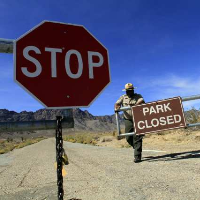Parks Get a Reprieve Despite Governor’s $31 Million Budget Veto

Most of the 70 state parks that were on the chopping block earlier this year have at least temporarily avoided the guillotine despite a $31 million line-item budget veto Thursday by Governor Jerry Brown.
The last-minute boost in park fortunes came from $10 million included in the budget deal signed off on by the governor. But his participation was not wholehearted. “I cannot fully support this action,” he wrote in his veto message, “because proposed funding either takes from other important purposes or may violate the state's agreement with the federal government regarding the State Water Pollution Control Revolving Fund.” The budget legislation had called for accessing that pot of federal money for the parks.
Private parties, non-profit organizations, cities and counties cobbled together deals across the state to stave off what would have been California’s first-ever mass closure of parks. Nearly one-fourth of the state’s 278 parks were at risk. As of one week ago, Department of Parks and Recreation Director Ruth Coleman was saying the state had managed to save 30 parks and that her “fantasy” was to get to 60. Parks officials said Thursday that they hit 65 and were working on reprieves for the other five—Benicia State Recreation Area, the California Mining and Mineral Museum, Gray Whale Cove State Beach, Providence Mountains State Recreation Area and Zmudowski State Beach—slated to close Sunday.
Although the budget deal assures that most parks will be open through the summer, many of the deals arranged statewide are of a temporary nature (often not exceeding one year) and don’t solve the problem of securing for them a long-term revenue stream. Voters rejected Proposition 21’s $18 registration fee for vehicles in November 2010 that would have raised an estimated $500 million for parks.
As park enthusiasts scrambled all year to secure funding, they turned to private individuals, conservation groups, local governments and, amid much controversy, companies with privatization plans. A March report by the Legislative Analyst’s Office estimated that the state could save millions of dollars by allowing private companies to operate more freely in parks and expanding the use of concessionaire agreements. It also recommended transferring ownership of some state parks to local governments, eliminating the use of peace officers for certain park tasks and increasing park user fees.
The state has already meandered down the park privatization path and is in negotiations on private operation of six parks: Castle Crags, Benbow Lake, Woodson Bridge, Brannan Island, Turlock Lake and Limekiln.
–Ken Broder
To Learn More:
California Parks Closure: Two-Thirds of Parks Could Be Saved Before Impending Shutdown (by Aaron Sankin, Huffington Post)
Two-Thirds of California Parks Set to Close May be Saved (by Paul Rogers, Mercury News)
California Parks Get Reprieve, Won't Close on Sunday (by Paul Rogers, Mercury News)
65 State Parks Will Temporarily Stay Open (by Jason Dearen, Sacramento Bee)
Strategies to Maintain California’s Park System (Legislative Analyst’s Office) (pdf)
- Top Stories
- Controversies
- Where is the Money Going?
- California and the Nation
- Appointments and Resignations
- Unusual News
- Latest News
- California Forbids U.S. Immigration Agents from Pretending to be Police
- California Lawmakers Urged to Strip “Self-Dealing” Tax Board of Its Duties
- Big Oil’s Grip on California
- Santa Cruz Police See Homeland Security Betrayal in Use of Gang Roundup as Cover for Immigration Raid
- Oil Companies Face Deadline to Stop Polluting California Groundwater





